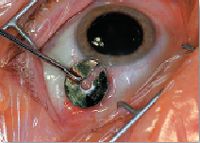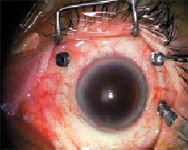Article
Availability of 23-gauge instrumentation a plus
Frankfurt, Germany?Twenty-three gauge vitrectomy instrumentation has become available and offers surgeons an alternative to 25-gauge instruments. Claus Eckardt, MD, looked at the pros and cons of these smaller instruments.


He and his colleagues opt to use 23-gauge instrumentation because 25-gauge instruments, in his opinion, are generally too small for more complicated cases.


When performing the vitrectomy, Dr. Eckardt explained that the sclerotomy should be made at an angle of about 30° to the sclera. The DORC inserter, which is a blunt instrument that has a spatula-like tip that merges with a cylindrical body holding a microcannula, allows easy insertion of the microcannulas into the scleral tunnel.
Regarding the brightness of the endoillumination with the 23-gauge system, he noted, that there is virtually no difference between it and the 20-gauge model.
Available instruments
Numerous 23-gauge instruments are now available and include a pneumatic vitreous cutter; wide-angle endoillumination probe; flute needle; endodiathermy probe and endolaser probe; end-gripping forceps; vertical, straight, and curved scissors; and hem-stopper.
"Twenty-three gauge vitrectomy instruments are used to carry out the most complicated procedures, for example, a diabetic retinal detachment that requires a 180° peripheral retinectomy. Cases such as these are best treated with silicone oil tamponade; the use of 1,000 and even 5,000-centistoke silicone oil is not problematic. The silicone tube can be mounted on the microcannula," Dr. Eckardt demonstrated.
Within the past 6 months, Dr. Eckardt and colleagues have performed more than 400 cases using the 23-gauge instrument. The cases have ranged in difficulty from simple macular pucker to giant retinal tears. Today, he pointed out, the only cases for which he still uses 20-gauge instruments are those that require the removal of 5,000-centistoke silicone oil, removal of a foreign body, and removal of subretinal membranes that require angled instruments. No cases required placement of a suture at the end of the surgery, and none required conversion to 20-gauge technique. In addition, we never injected air to tamponade the sclerotomy," he reported.
Complications included the development of postoperative hypotony in 22 eyes that normalized after 2 days. Postoperative retinal detachments developed in three eyes, and endophthalmitis developed in two eyes.
Newsletter
Don’t miss out—get Ophthalmology Times updates on the latest clinical advancements and expert interviews, straight to your inbox.





